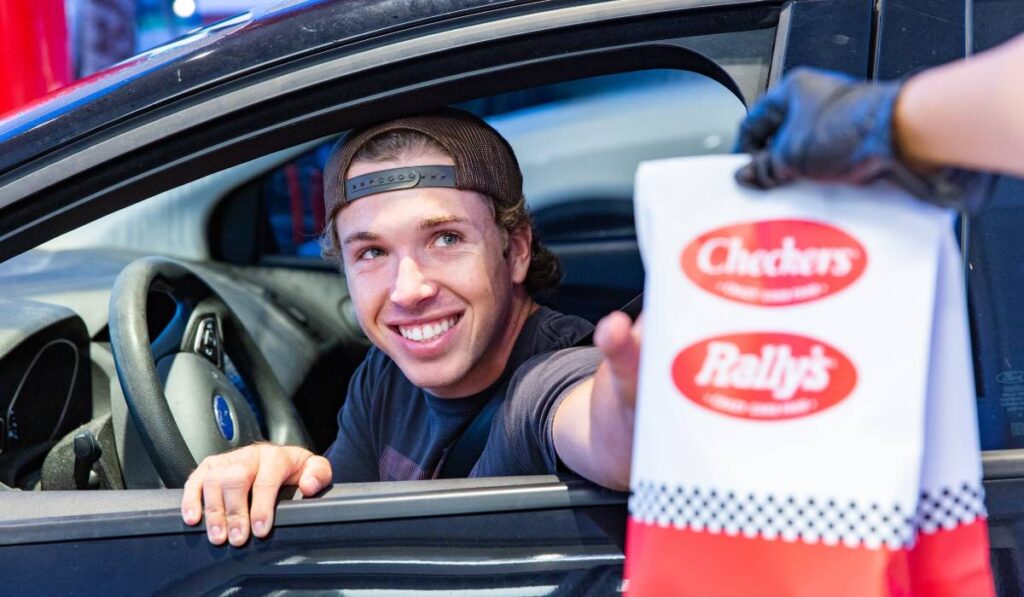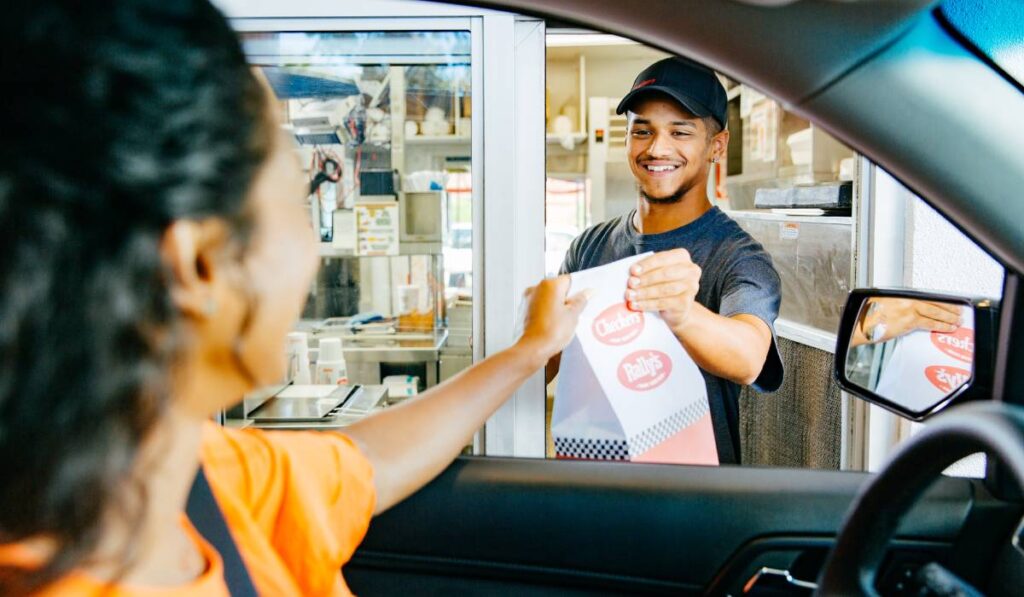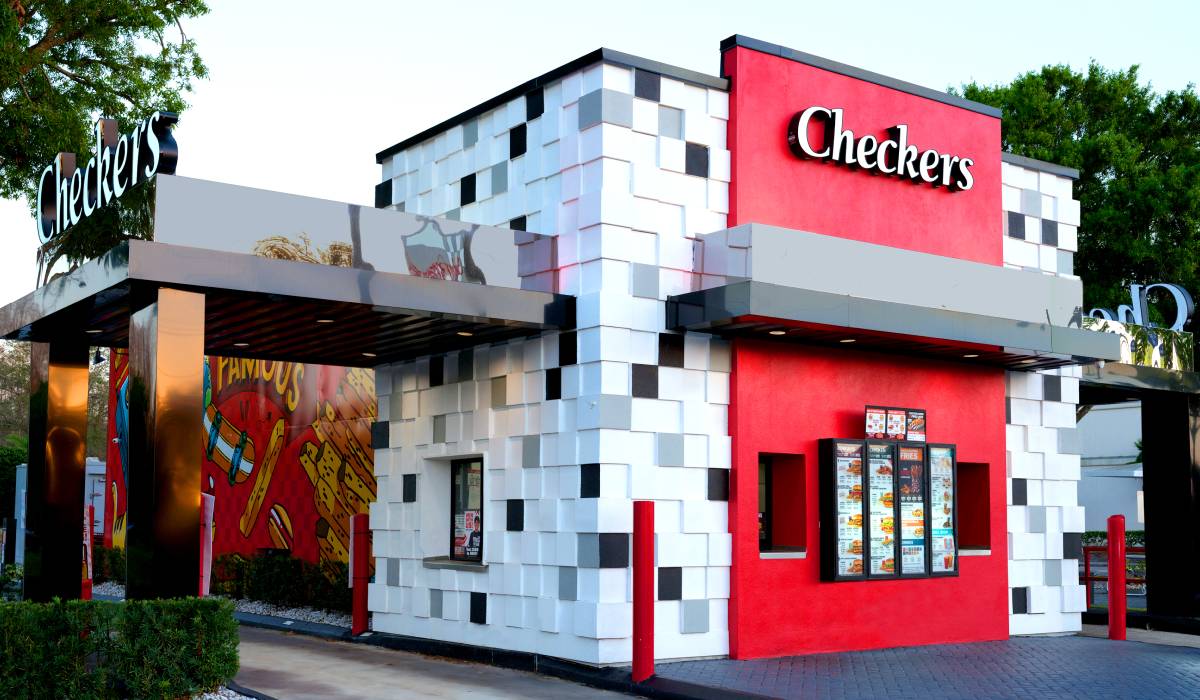Frances Allen’s first few weeks as CEO of Checkers & Rally’s were exceptionally crucial. Taking on the lead role of an 800-plus-unit company is inherently challenging, but her onboarding process had the unique twist of coming right before the unprecedented global COVID pandemic.
Without knowing what would truly unfold in the following months, Allen smartly planned her training well ahead of time. While the office remained open, she had the opportunity to meet with everyone, engage with franchise advisory committees, and visit restaurants in a couple of markets.
Allen felt she was grounded in the brand before the chaos—a level of stability that was necessary to move forward with what she described as a “crisis committee.” The group met every day for an hour. So when offices in Tampa, Florida, closed in late March, the chain was prepared to keep its employees and customers safe. Fifteen new operational procedures were deployed. “I guess you can look back in hindsight and say it’s a good thing that we are in Florida because we tend to get hit by hurricanes,” Allen says. “And as a result, we had some pretty well-defined crisis management, and we didn’t really miss a beat.”
There were adjustments at the restaurant level, like leaning into delivery and prioritizing contactless exchanges of money. But Checkers was in a much better position to ramp up those changes through its decades of experience in drive-thru operations. Not only that, but dual lanes, walk-up windows, and no interior seating—a mode of operation consumers swarmed to when dining rooms shut down nationwide.
“I was so impressed with the way this organization moved so incredibly fast,” Allen says. “Organizations have an innate DNA. That was one of the things that was very important that I understood. It was nothing like the pandemic to actually demonstrate to me what this organization’s DNA was all about. We’re the small player, relatively speaking. And therefore, we have to try harder, we have to move faster, and there’s can-do scrappy resilience about the people in this organization that’s just spectacular. And it’s shown through in the pandemic. It’s still there today. It was not manufactured.”
Perfecting the drive-thru
One of the biggest initial shifts was dedicating one drive-thru lane to mobile order pickup across company-owned locations.The brand considered the move before COVID arrived, and like most tech-forward initiatives during the pandemic, innovation timelines accelerated.
Because Checkers already had an extra lane to spare, the change mostly required signage and training to ensure employees, customers, and third-party delivery drivers understood how to navigate two different drive-thrus. Fast forward to 2023, a majority of corporate locations have dedicated e-commerce lanes, except for a few stores where the volume is too high through both lanes.
Checkers didn’t mandate this change to existing franchisees, but it did share data proving guests were more satisfied with their experience—not just the speed, but the quality of food, accuracy, and other metrics. However, nowadays when the brand looks into approving sites, it must have a mobile order lane. There’s an occasional exception if it’s great real estate and doesn’t have room for two lanes or if it’s a conversion that makes economic sense.
Systemwide, the digital lane has become an important part of business, especially since Checkers is testing pickup through DoorDash.
“That is a new innovation,” Allen says. “We expect that to do very well. The customer gets to save on the delivery cost and we get all of the benefits of being able to plan ahead and the customer still has all the convenience of picking up ahead. So we think that e-commerce lane is just going to become more and more important. … I think operators, especially during the pandemic, they saw the sense of it and where it worked in their restaurants. I think the majority of them actually implemented it.”
The mobile order lane is a key feature of Checkers’ “restaurant of the future” prototype. The new design, which began rolling out in 2021, aims to address multiple opportunities—one of those being the new digital drive-thru. Another is the modernization of Checkers’ exterior.
The next is streamlining the interior. The company conducted a study that found workers were collectively walking an unnecessary mile and a half per hour. The chain implemented a FIT Kitchen, which not only reduces that wasted energy, but also replaces flattops with clamshell grills and features holding equipment to keep items hotter for longer and fry and grill stations with better capacity. The format allows for Checkers’ fry-seasoned chicken tenders—an innovation that launched systemwide in early 2022 after having one of the most successful pilots in the past decade.

From late 2021 onward, new Checkers locations have opened with this new prototype for the most part. This year, the brand expects to debut roughly 40 restaurants nationwide. Meanwhile, the company is working to remodel existing stores with the new assets. Checkers improved all five of its restaurants in Jacksonville; the last one was completed in May, and the early results have been “extraordinary,” Allen says.
“Our theory is if we get a whole market looking like this the results from the remodel will be even better and it just shows the brand has so much appeal, so much character,” Allen says. “And all of that comes out in the remodel itself—it’s brighter, better lighting, more colorful, and more modern contemporary look. That is really encouraging a guest to come back. And the good thing is having the FIT Kitchen in there already, when they come back they’re getting a better experience. We’re also finding that our employees love the new look and so it’s easier to recruit and retain in the remodeled restaurants, which means that the guest is getting a better experience. We could not be more thrilled with how that is going.”
Allen says franchisees are “very open” to new ideas and that they are waiting on Checkers to formally announce results from its redesigned restaurants. Franchisees comprise 70 percent of the footprint. Operators were running about 550 locations at the end of 2022.
Currently, there are 10 remodeled units in the system, which, according to the CEO, makes for “a very strong test.” The plan is to share official financials during the brand’s franchise convention in December. Similar to most restaurants, Allen says 20 percent of operators want to move even faster than the company, 20 percent resist change, and then a middle 60 percent wait to be convinced.
“That’s the important thing. What is the ROI?” Allen says. “They’re smart business people and we want to make sure that we’re asking them to invest in something that’s actually going to deliver for them.”
An AI pioneer
Checkers has prided itself on being a leader in the drive-thru space since its inception. So completing an exploration of AI voice ordering—more in-depth than any other quick-service chain in America—made complete sense for the brand.
With many customers opting for drive-thru, even into the post-pandemic future, Checkers recognized how much pressure that put on employee execution. The worker is expected to take an order from a customer at the speaker box and quickly prepare the meal for the previous guest. All of this has to be done quickly and courteously, with polite phrases such as “please” and “thank you.”
“This is a very, very stressful position,” Allen says. “That’s why we were so passionate about being able to implement voice-activated ordering. … There’s no human error there with people getting orders mixed up. It is much more accurate. It is such a stress reliever for the customer. It’s been hugely beneficial for us, and our employees love it. That’s the most important thing.”
Chief information officer Minh Le began in 2019 and entered the brand with 20-plus years of restaurant technology experience and a mindset of pushing innovation to make jobs easier. Before COVID, Le was aware of automated ordering technology in quick service through phone calls. His idea was to replicate it but in a drive-thru setting. So around 2020, Checkers started down that path and spent six months in its lab playing with different scenarios. About that time, COVID was hitting and so were labor shortages. All of it catalyzed the adoption of voice ordering.
Checkers initially used two companies that were pioneers in the space and “pretty much put them through the wringer in our lab,” Le says. About three months into monitoring the technology, Presto—which served as a reseller of Hi Auto’s conversational AI technology—joined the ongoing experiment. Since Checkers was still in the early stages, Le was open to more companies. And looking back on it, the executive is thankful for that decision. The brand threw all of the same challenges toward Presto and Hi Auto, and within the first 30 days, they were able to achieve or surpass what the other two companies spent several months trying to do.
“Right then we knew that, hey, [Hi Auto] is different,” Le says. “[Hi Auto] is invested, they have the talent, they have the motivation, the skillset to make this thing work.”
The burger chain first unveiled its partnership with Presto in January 2022. And Checkers wasn’t revealing a pilot either. The chain was ready to roll out the AI technology to its entire company footprint, becoming the first quick-service chain to scale the innovation. As of July, nearly 400 restaurants had automated voice ordering, including some franchised stores. Le estimated that about 70 percent of corporate units have the technology.
There are several reasons why Checkers hasn’t yet reached 100 percent of company-owned restaurants. One is that leadership knew franchisees wanted the technology, so it slowed the corporate side to allow operators to gain traction. The other part is that as Checkers stepped ahead, it was learning a lot. The brand started with a one-size-fits-all approach, but as the technology grew to more markets, the chain realized that the AI needed fine-tuning to adapt to each area’s idiosyncrasies.
The process began in Florida and expanded to the Southeast, East Coast, and West Coast. The AI is essentially in every Checkers region, and franchisees have patiently been waiting in line to get the technology installed. The reality, however, is that the brand will never truly reach 100 percent. There are some markets where it doesn’t make sense, like all the nontraditional locales.
Right now, it’s optional. Typically when it comes to technology, innovation doesn’t become standard until there’s 85 percent adoption, Le says. The executive predicts that will happen in the future based on the excitement from operators.
Checkers first introduced AI voice ordering to franchisees during its convention in December 2021. Le showcased samples of audio and hosted on-site visits with franchisees.
“After that, they were just sold,” Le recalls. “They see the value, the technology, they see the feedback from the managers, the cashiers, how much easier it made their lives. It wasn’t hard to coerce them or to get them to volunteer after that. We’re about 30 corporate locations in at that point already. But we had well over 200 franchises signed up within the first month.”
Having a big list left Checkers with the daunting task of scaling a new piece of technology that wasn’t widely recognized across the country. As the chain traveled to different states it discovered that not many technicians had installed AI voice ordering before. There was a learning curve in getting a core set of workers to install everything remotely and copy the process instead of sending crews to one location at a time.
The other piece was dealing with cloud technology and reaching capacity.
“Once you start getting to a certain point, you hit a maximum capacity where you have to increase that capacity,” Minh explains. “I know cloud technology is fairly elastic, but even with the elasticity, the cloud, if you think of what it takes for this technology to work, you’re recording audio in real-time, sending it all the way through the cloud and having the natural language processing translate that audio into text, translate the text into a menu item or a response to a question, and send back down in real-time. That’s within a second or so doing all that work.”
“It’s easy for 20-25 locations, but you do it for 100-plus locations and that gets really tough,” he adds. “It took us and our vendor a little time to see where the bottlenecks are and work through the bottlenecks where we’re able to scale.”
At the approximately 400 locations, Checkers is running 2.5 million transactions per month through the AI system with 95 percent accuracy. There were a few outages in 2021 and early 2022. Since then, the automated voice ordering has been 99.99 percent reliable. There are those customers that refuse to talk to a computer, especially the older generation, but a majority of guests have appreciated the swiftness and politeness of the digitized voice.
A key point, Minh says, is that AI isn’t meant to be a replacement. It’s supposed to complement human workers and fill a gap if a restaurant is unable to hire or when an employee calls in sick.
“You could yell at AI; it doesn’t care,” Minh says. “It doesn’t get its feelings hurt, it won’t quit. It will just be as polite as possible and try to do what it was programmed to do. Customer side, you have people that like that about the AI. And on the employee side as well. The employees, the managers, I’d say 98 percent of them love the system and it’s there when needed. When employees call in, the store could still run with the AI. It solves a lot of labor problems right there. There’s a real value in filling that labor gap that’s always been missing, especially since the start of COVID.”
AI-enabled restaurants experience 7 percent faster service than non-AI stores. With average check, it’s fairly flat—something Checkers is looking to improve with the technology’s upselling capabilities. Currently, the AI has a static upsell by daypart. The goal is to take different attributes and make it smarter, like recognition of male/female voices, weather, and time of day.
In the past year, several quick-service chains have publicly stated their experimentation with drive-thru AI, including Panera, Wendy’s, Del Taco, CKE Restaurants (Hardee’s and Carl’s Jr.), and Wienerschnitzel.
Le foresees exponential growth in the space over the next year to year and a half. “We’ve been working with Siri, Google, Alexa for so long,” Le says. “Today’s consumer is expecting that now. And now with a lot of restaurant technologies jumping onboard and even large restaurant companies recently announcing their rollout, there are so many more that haven’t announced that have been playing with that technology and slowly rolling out before they make that announcement.”

Stabilizing the future
Amid all of the drive-thru changes, Checkers is forging ahead with new leadership.
In June, the fast-food brand announced that majority ownership switched from private equity firm Oak Hill Capital Partners to senior lenders Arbour Lane Capital Management, Garnett Station Partners, and Guggenheim Investments. The change helped Checkers reduce long-term debt from $300 million to $75 million. A lot of that financial burden came from when Oak Hill Capital bought Checkers for $525 million in 2017.
The chain also received $25 million for remodeling and growth initiatives. That’s on top of the $20 million Oak Hill Capital provided in 2021. Allen couldn’t be more upbeat about the recent transaction.
“We’ve performed well in the first half of this year, overcoming a lot of the challenges of inflationary pressures last year,” Allen says. “It just gives me enormous confidence that our five-year plan is working and that we can now move forward both profitably and achieve long-term success. It’s a huge positive for the brand and our stakeholders.”
The CEO says the chain has 3x whitespace just in the states it currently operates, and expansion is being led by a 50/50 split of new and existing franchisees. She describes the pipeline as “robust,” and adds that Checkers is continuing to find smaller “A” and “B+” sites, despite other chains downsizing their prototype square footage.
Checkers finished 2022 with $858 million in systemwide sales and an AUV of $996,400. The brand is encouraging expansion with incentives and said earlier this year that it’s interested in the West and East coasts—California, Nevada, and Arizona on one end and North Carolina and South Carolina on the other.
Inflation impacted Checkers significantly in 2022. The cost of equipment, food, and construction was considerably higher than in 2018/2019. The good news, Allen says, is that the brand has been able to match rising expenses with bigger revenue numbers. New stores are having record weeks, proving there’s a sizable demand for the Checkers brand. The same goes for franchisees wanting to make a strategic investment.
“I think many are looking to add a burger chain to their portfolios,” Allen says. “We’re seeing more and more multi-unit franchisees coming in. They’re looking for the more personal attention that they get from us versus some of the bigger brands. They could be a franchisee that really is dedicated to that community and sees there’s something missing. They loved our food growing up, they loved our fries, and they’re also very attracted to the fact that we are this pioneering, leading format right now in drive-thru. It’s still relatively less to build a Checkers than others. It’s a very, very efficient format. And they’re very attracted to that. They have seen that be really effective and efficient during the pandemic.”









